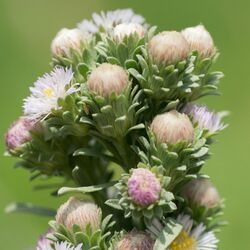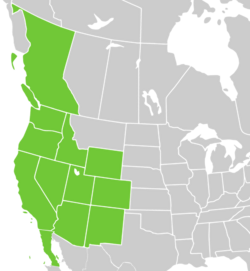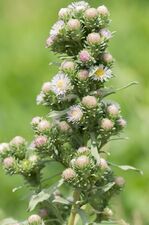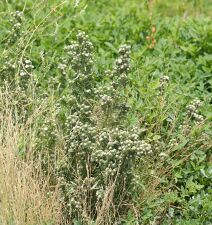Biology:Symphyotrichum frondosum
| Symphyotrichum frondosum | |
|---|---|

| |
Invalid status (NatureServe)[1]
| |
| Scientific classification | |
| Kingdom: | Plantae |
| Clade: | Tracheophytes |
| Clade: | Angiosperms |
| Clade: | Eudicots |
| Clade: | Asterids |
| Order: | Asterales |
| Family: | Asteraceae |
| Tribe: | Astereae |
| Subtribe: | Symphyotrichinae |
| Genus: | Symphyotrichum |
| Subgenus: | Symphyotrichum subg. Symphyotrichum |
| Section: | Symphyotrichum sect. Conyzopsis |
| Species: | S. frondosum
|
| Binomial name | |
| Symphyotrichum frondosum | |

| |
| Native distribution[3] | |
| Synonyms[2] | |
|
Basionym
Alphabetical list
| |
Symphyotrichum frondosum (formerly Aster frondosus) is a species of flowering plant in the family Asteraceae native to western North America. Commonly known as short-rayed alkali aster,[4] it is an annual or perennial herbaceous plant that may reach 140 centimeters (55 inches) tall.
Description
Symphyotrichum frondosum is an annual or occasionally perennial herbaceous, flowering plant growing a leaning or erect stem to a maximum height of 5–140 centimeters (2–55 inches). The leaves are a few centimeters long and oval in shape with rounded tips. The stem and leaves are mostly hairless.[3]
The inflorescence is a small array of flower heads containing many short pale pink or lavender ray florets and yellow disc florets. The fruit is a hairy cypsela with white to yellow-tinted pappi.[3]
Distribution and habitat
It is native to North America in the west from British Columbia, south to Baja California (Mexico), east to New Mexico, and north to Wyoming and Idaho. Symphyotrichum frondosum grows in wet habitats such as marshes and meadows, especially in alkaline or saline conditions.[3]
Citations
References
- Flora of North America Editorial Committee, ed. (2006), "Symphyotrichum frondosum", Flora of North America North of Mexico (FNA), 20, New York and Oxford, http://www.efloras.org/florataxon.aspx?flora_id=1&taxon_id=250067649, retrieved 4 July 2021
- "Symphyotrichum frondosum Alkali Aster". Arlington, Virginia. 2 July 2021. https://explorer.natureserve.org/Taxon/ELEMENT_GLOBAL.2.139828/Symphyotrichum_frondosum.
- POWO (2019). "Symphyotrichum frondosum (Nutt.) G.L.Nesom" (in en). Royal Botanic Gardens, Kew. http://www.plantsoftheworldonline.org/taxon/981827-1.
- ((USDA, NRCS)) (2014). "Symphyotrichum frondosum". Natural Resources Conservation Service PLANTS Database. USDA. https://plants.usda.gov/core/profile?symbol=SYFR2.
External links
Wikidata ☰ {{{from}}} entry
 |




